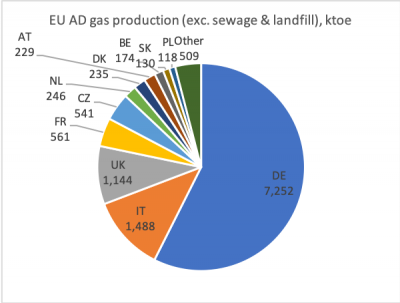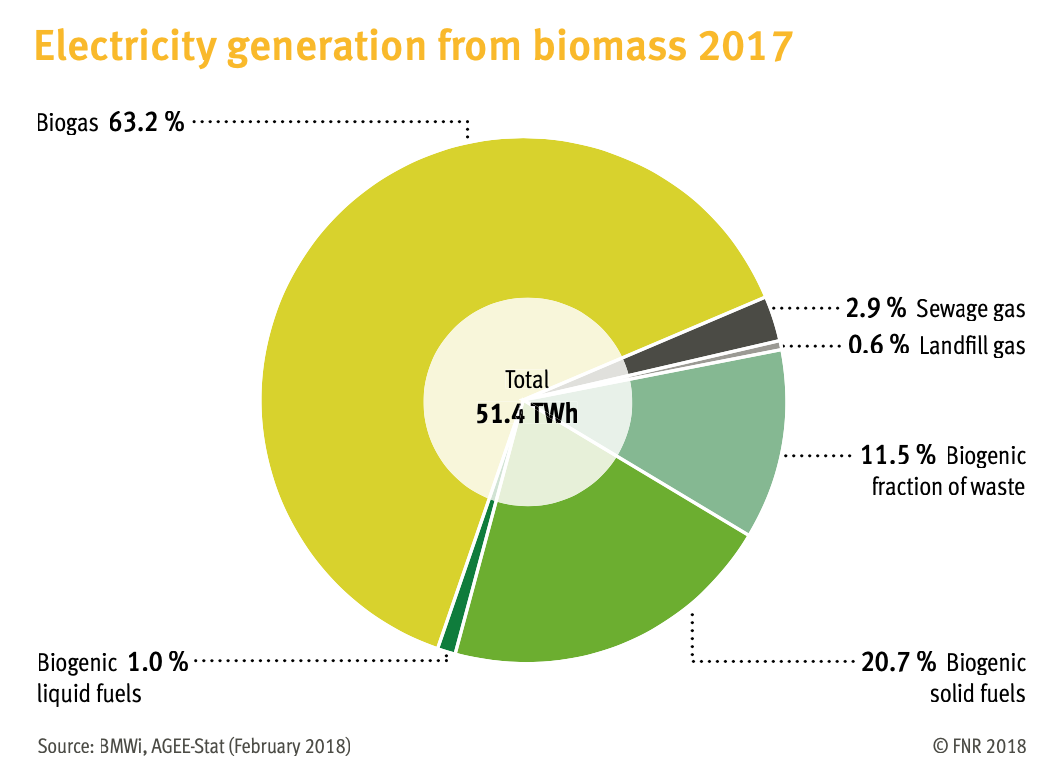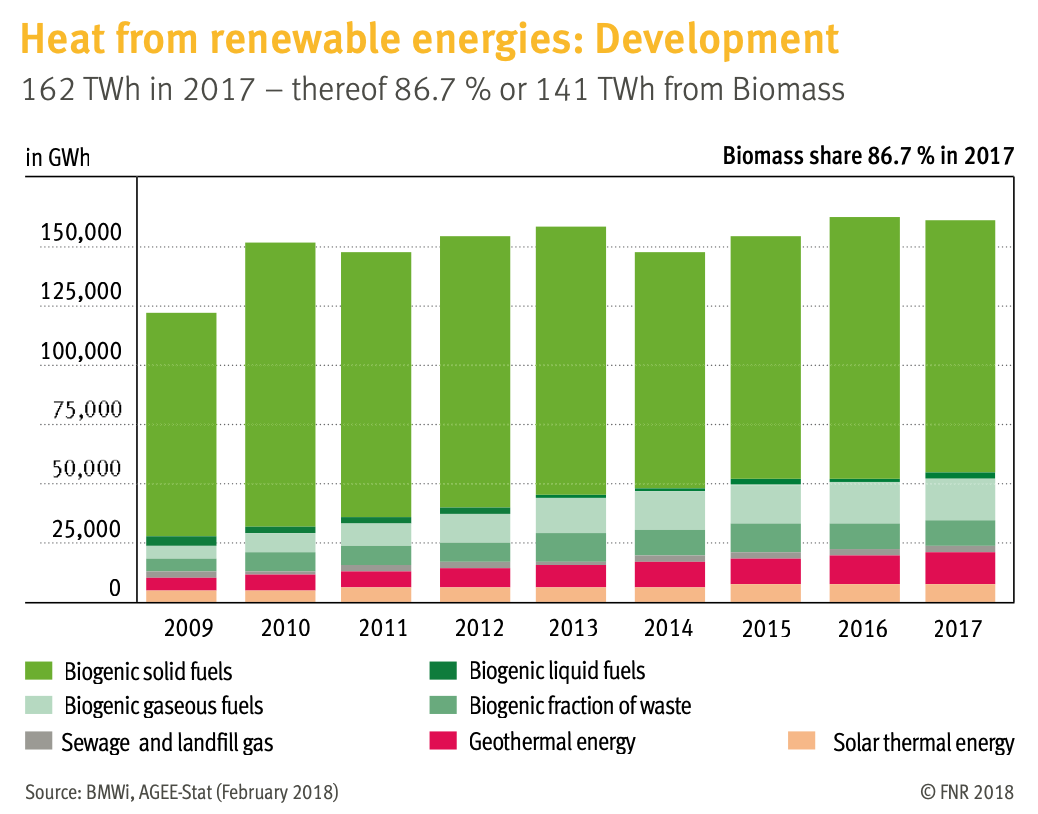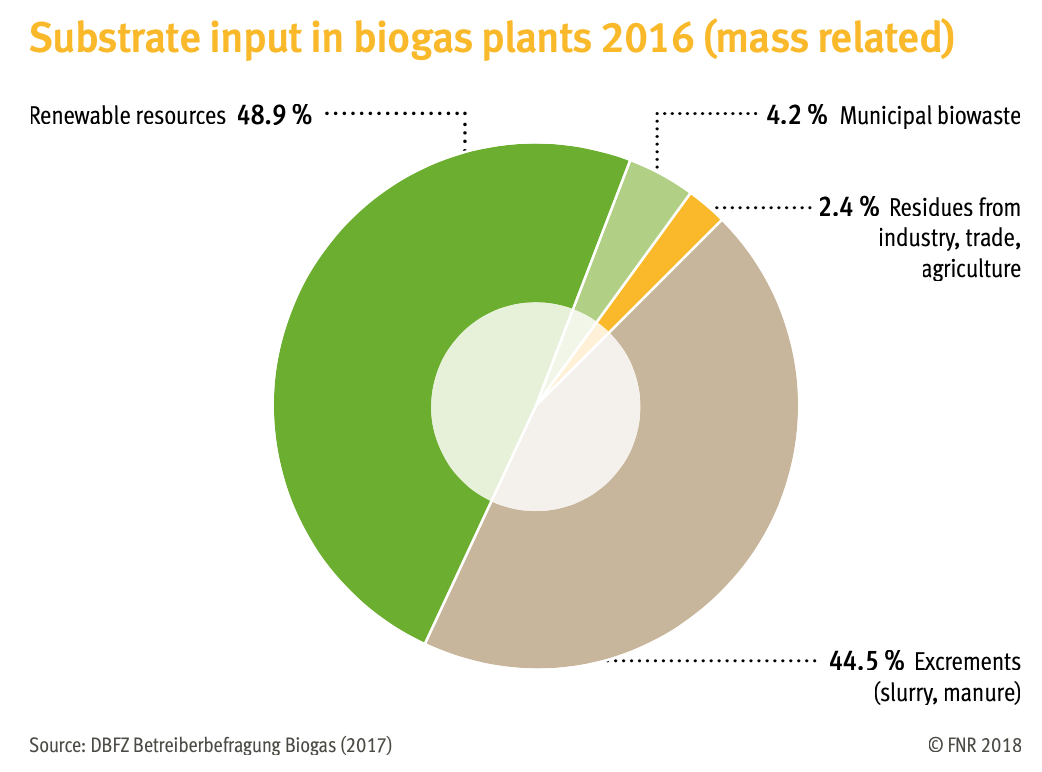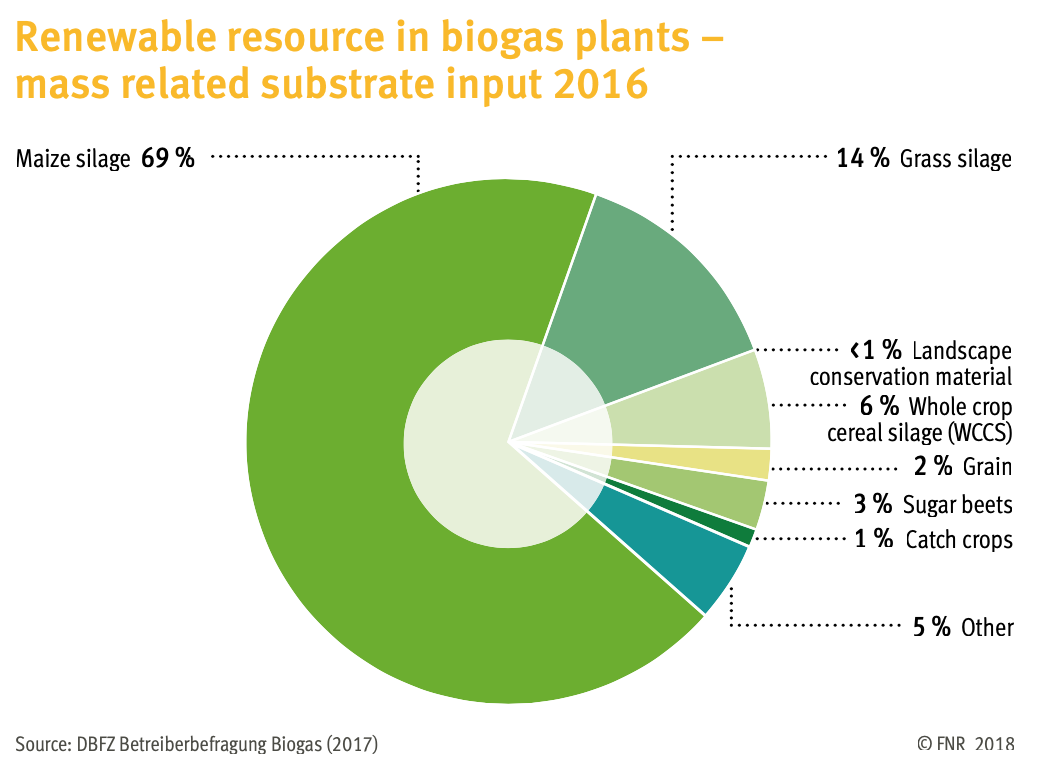NG/E&Y potential: N/A
Credible potential: 250 - 2,500m m3
Ernst & Young considered only “a possible limited contribution from sustainable energy crops” for gasification (none for digestion), even though Enviros had relied heavily on it in their most ambitious scenario for the potential of biogas.[1] The “food vs fuel” debate was a hot topic, and E&Y no doubt judged that it would raise political resistance to rely on energy crops.[2]
In practice (and in theory to most analysts, then and now, other than E&Y), energy crops are the only way to expand biogas production beyond the limited potential of waste resources. But there is a practical limit even to the grandest ambitions.
Germany has made by far the largest effort to develop biogas.[3] It has relied heavily on energy crops to do so.[4]
Germany has devoted 14% of its agricultural land (2.35m ha, 8% of its undeveloped land) to energy crops. Of this, nearly 60% (1.37m ha) is for biogas feedstocks. Yet biogas represents 2.2% of Germany’s primary energy consumption.[5] Biogas represents around 5% of Germany’s electricity and around 1.4% of its heat, and an insignificant proportion of their transport fuels.[6]
Germany illustrates the competition for land where significant reliance is placed on energy crops. Most of the rest of the energy-crop land (964,000 ha) is for the production of liquid fuels (biodiesel and bioethanol). Liquid fuels are hard to replace in some uses, such as aviation fuel. Biofuels are not currently used much for aviation in Germany (or elsewhere). They represent 4.7% of the fuel consumption for land transport.[7] If used for aviation, this volume would represent around 24% of Germany’s requirements.[8]
Nearly one-third of Germany’s land is forested, compared with 13% of the UK’s land. The Germans have utilised solid biomass (primarily wood) to a greater extent than the UK. The Germans do not waste so much of this resource as the UK generating electricity at around 35% conversion efficiency. Most of it is used to produce heat (direct or as CHP) at around 80% efficiency.[9]
|
|
Germany |
UK |
|
Total land area (k ha) |
35,700 |
24,400 |
|
Woodland area (k ha) |
11,400 |
3,200 |
|
Agricultural land area (k ha) |
16,700 |
17,500 |
|
Energy crops area (k ha) |
2,350 |
94 |
|
Area for AD feedstocks (k ha) |
1,374 |
57 |
|
Area for biofuel feedstocks (k ha) |
964 |
27 |
|
Area for solid energy crops (k ha) |
11 |
10 |
|
Primary energy consumption (TWh) |
3,469 |
2,056 |
|
Total gas consumption (TWh) |
937 |
880 |
|
Household energy consum. (TWh) |
658 |
431 |
|
Household gas consumption (TWh) |
279 |
309 |
|
Heat from solid biomass (TWh)[10] |
107 |
44 |
|
Heat from biogas (TWh)[11] |
17.2 |
4.6 |
|
Liquid biofuels (TWh)[12] |
31.5 |
5.9 |
The UK has a lot less land than Germany dedicated to the production of solid fuels (e.g. wood), liquid fuels (biodiesel/ethanol) and gaseous fuels (biogas). If we focused on expanding one aspect (e.g. energy crops for biogas), we would miss the contributions of the other types of energy. And all of them compete with the traditional use of agricultural land for food production.
Enviros envisaged the use of 157,000 ha for the production of energy crops for AD in their most ambitious scenario. Ernst & Young discounted the possibility altogether.
94,000 ha are used to grow energy crops in the UK, out of a total utilised agricultural area of 17.5m ha.[13] We have 3.19m ha of woodland.[14] Our total land area is 24.4m ha.
Germany has 2.35m ha growing energy crops (out of 16.7m ha of agricultural land) and 11.4m ha of forest, out of a total land area of 35.7m ha. Yet Germany meets only a small proportion of its energy requirements from these fuels. Is there (and was there ever) a credible model for the UK to produce a material proportion of its energy requirements from a smaller area of land? And if not, what is the model for biogas to make a material contribution to the UK’s energy supplies, given that it can only be stretched to Germany’s modest contribution through orders of magnitude higher use of land for energy production than we currently deploy?
Let’s imagine that the UK increased the level of energy crop production to the same as Germany. 14% of UK agricultural land = 2.45m ha. 58% of this (1.43m ha) is used to produce AD feedstocks, while 41% (1m ha) is used to produce liquid biofuels. The German experience suggests around 45MWh/ha p.a. for biogas from energy crops.[15] We could produce 64.35 TWh of biogas, i.e. around 5.9bn m3. That represents around 17% of domestic gas consumption or 6% of total gas demand, according to Ernst & Young’s projections. In practice, gas consumption has fallen somewhat, and this amount would represent 21% of domestic gas consumption and 7% of total gas demand.
We need additionally to allow for the reforestation that is (a) part of this government’s policy, and (b) required to match the German model. To bring us up to German levels of afforestation, we will need to switch another 4.6m ha from agricultural use to forestry. Our agricultural land area would be reduced from 17.5m ha to 10.5m ha.
Or we might choose to have less forest than Germany. In that case, we will either have to import more solid biomass fuels, or use less solid-biomass heat, which currently makes up approximately two-thirds of Germany’s renewable heat.
For reasons of climate policy, the UK (like many countries around the world) plans to increase significantly its forested area. Without deforestation or a substantial reduction in agricultural production, the potential for energy crops in the UK will have to be kept within reasonable bounds that constrain the potential of digestion or other conversion technologies.
[1] See above: 157,000 ha of land for energy-crop production, contributing to total biogas production equal to <4% of total heat demand.
[2] e.g. David J Tenenbaum, “Food vs. Fuel: Diversion of Crops Could Cause More Hunger”, Environ Health Prospect, Jun 2008. https://www.ncbi.nlm.nih.gov/pmc/articles/PMC2430252/
[3] Bioenergy Europe, Statistical Report 2019, Biogas section Table 2
[4] Fachagentur Nachwachsende Rohstoffe, Bioenergy in Germany, Facts & Figures 2019, http://www.fnr.de/fileadmin/allgemein/pdf/broschueren/broschuere_basisdaten_bioenergie_2018_engl_web_neu.pdf
Given the different gas potential of energy crops and excrements, this means that energy crops are responsible for around two-thirds of Germany’s biogas.
[5] Bioenergy in Germany, Facts & Figures, p.39: used share of biogas primary energy potential: 273 PJ = 75.8 TWh. Eurostat, T2020_33, Primary energy consumption. Germany (2017): 298.31 ktoe = 3,469 TWh https://ec.europa.eu/eurostat/databrowser/view/t2020_33/default/table?lang=en
[6] Data from Bioenergy in Germany, Facts & Figures 2019. Gross electricity generation: 654.8 TWh. Electricity generation from biogas: 63.2% of 51.4 = 32.5 TWh. Renewable heat (162.2 TWh) share of final energy consumption for heat: 12.9%. Biogas share of renewable heat: 10.6%
[7] ibid. p.28. Total land transport fuel consumption: 57.6 Mtoe = 670 TWh. ∴ Biofuels = 31.5 TWh
[8] Germany’s jet fuel consumption 2018: 221,010 barrels of oil per day = 131.3 TWh p.a. https://www.theglobaleconomy.com/Germany/jet_fuel_consumption/
[9] ibid. pp.5-6.
[10] Excludes biogenic fraction of waste. UK figure based on DUKES 6.1.1 depends on highly-suspect estimates of domestic wood burning. Reality is probably roughly half.
[11] Excludes sewage gas and landfill gas
[12] UK: 599m litres @ 9.8 kWh/litre. Germany: 4.7% of 57.6m toe total land transport fuel consumption.
[13] 27,000 ha are for liquid biofuels. 57,000 ha are for AD (primarily maize). 10,000 ha are for solid biomass. https://assets.publishing.service.gov.uk/government/uploads/system/uploads/attachment_data/file/856695/nonfood-statsnotice2018-08jan20.pdf
https://assets.publishing.service.gov.uk/government/uploads/system/uploads/attachment_data/file/747210/structure-jun2018prov-UK-11oct18.pdf
[14] https://www.forestresearch.gov.uk/tools-and-resources/statistics/statistics-by-topic/woodland-statistics/
[15] This assumes mostly the highest-yielding crop – maize silage – is grown, but some land is not suitable and requires lower-yielding crops.

